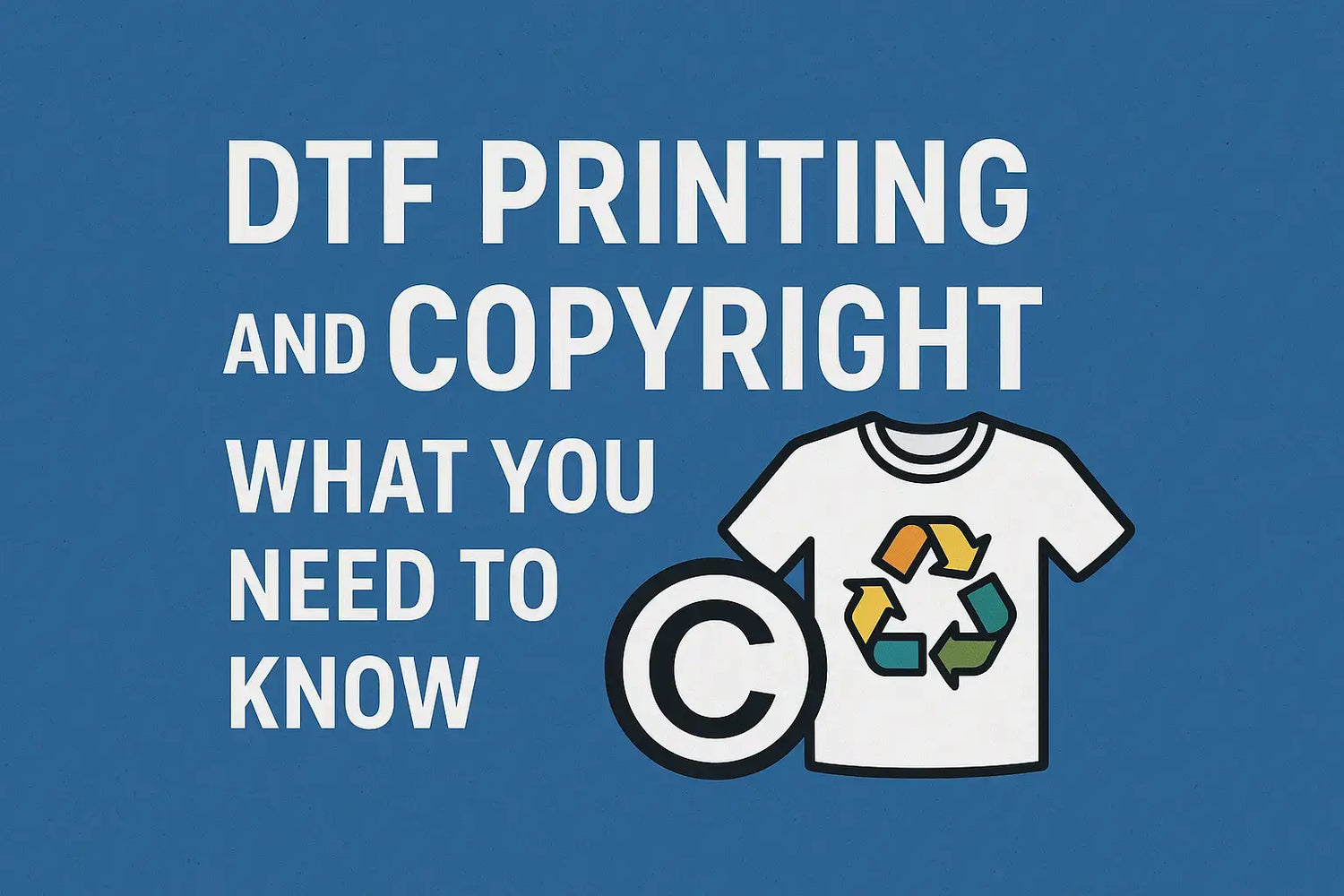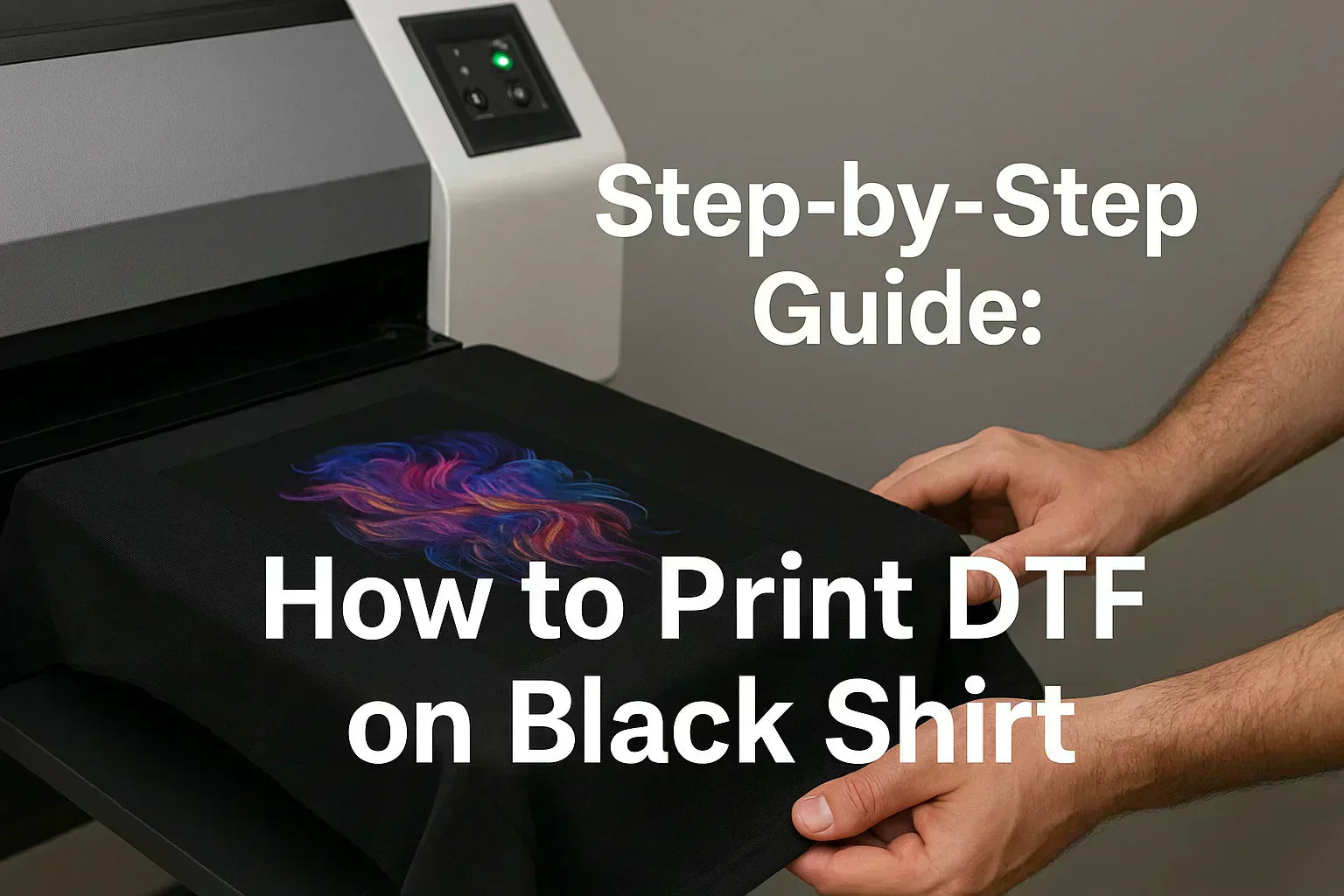Introduction
DTF (Direct to Film) printing is a well-known way to add custom designs to clothing using a special printer, transfer film, and a heat press. Copyright issues in DTF printing occur when designs include protected material used without permission. To stay safe, always use original artwork, obtain permission from the copyright owner, or choose designs from the public domain.
In this blog, we’ll discuss the most common copyright issues in DTF printing and share tips on how to avoid them to keep your business safe.
Key Takeaways
- Copyright laws protect original designs, images, and creative works.
- Using copyrighted material without permission can lead to legal and financial consequences.
- Understanding licensing, public domain, and fair use is essential for DTF printing.
- Always get written permission or create original artwork to stay safe.
What is DTF Printing?
In DTF printing, the design is first printed on a special film, then covered with adhesive powder, and finally pressed onto the fabric using heat. This process allows for sharp, full-color prints that work on cotton, polyester, blends, and even dark fabrics.
Because it’s so versatile, DTF printing is widely used for custom clothing printing — from branded merchandise to personalized gifts.

Understand Copyright Law Basics
When it comes to DTF Printing and Copyright, knowing the basics of copyright law can save you from a lot of headaches (and potential legal trouble). Let’s break it down in simple terms.
What is Copyright?
Copyright is like a shield for creators. The moment someone creates something original—whether it’s a graphic, illustration, photograph, slogan, or piece of writing—it’s automatically protected by copyright law. In the apparel printing world, this means your unique t-shirt artwork, catchy tagline, or custom illustration is legally yours from the second you make it.
How Does Copyright Work?
Once something is copyrighted, the creator holds exclusive rights to use, reproduce, distribute, or sell it. That means you can’t legally print someone else’s artwork or logo on your t-shirts, hoodies, or other apparel without their permission. Doing so is essentially taking their work and turning it into your product—which is exactly what copyright law is designed to prevent.
What is Fair Use?
Fair use is a legal concept that allows certain copyrighted materials to be used without permission—but only in very specific cases, like education, commentary, criticism, or parody. The tricky part? What qualifies as “fair use” isn’t always clear. Many people assume their design falls under fair use when it actually doesn’t. Always check before you print.
How is Copyright Enforced?
Copyright owners don’t take violations lightly. They can send takedown notices, issue hefty fines, or even take you to court. Big brands and media companies often have entire legal teams dedicated to tracking down and stopping unauthorized use of their work. In short—printing without permission can get expensive, fast.
Copyright Issues in DTF Printing
Copyright issues in DTF printing can’t be overlooked. Understanding what’s legal—and what’s not—helps you avoid penalties and protect your business.

1. Printing Copyrighted Designs Without Permission
If a design belongs to someone else, you need their approval before printing it — plain and simple. Even if you’re not selling the item, giving it away or sharing it can still land you in legal trouble.
2. Use of Logos, Characters, and Trademarks
Those famous sports team logos, movie characters, and brand symbols are protected by trademark laws. Printing them without the proper license is illegal — yes, even if a customer insists on having them.
3. The Risk of Using Online Images
Just because you find an image on Google, Pinterest, or Instagram doesn’t mean it’s free to use. Most online images are protected by copyright, and using them without permission can result in legal action.
4. Misuse of Celebrity Images
Printing a celebrity’s face, name, or signature without consent — especially on products you plan to sell — can violate their right to publicity and lead to lawsuits.
5. Assuming “Personal Use” is Always Safe
Many people believe printing a copyrighted design for personal use is fine. But if you gift, share, or post the item online, it could still count as copyright infringement.
Key Considerations for DTF Printing
When you’re working with DTF printing, staying on the right side of copyright law is a must. Knowing a few things now can help you stay away from legal problems later. Here are some key points to remember.
1. Copyright Ownership
Always make sure the designs you print are either your original work or something you’ve obtained with proper rights. If you didn’t create it, you need permission to use it.
2. Public Domain
Some creative works are in the public domain, meaning they’re free for anyone to use. Still, don’t assume—check reliable copyright databases to confirm before printing.
3. Licensing
If you want to use artwork, fonts, or graphics for commercial purposes, buy the appropriate licenses. This small investment can prevent costly disputes.
4. DTF Service Provider Responsibility
If you’re offering DTF printing services, don’t just take the customer’s word for it—ask for proof that they own or have permission to use the designs they submit.
5. Client Agreements
Include a clear clause in your contracts stating that clients are responsible for ensuring their designs comply with copyright laws.
6. Educate Your Team
Train everyone involved in the DTF printing process about copyright rules so there’s no unintentional misuse of protected material.
7. Keep Records
Maintain copies of all licenses, agreements, and permissions. These documents can be your best defense if a legal question arises.
8. Penalties for Infringement
Ignoring copyright laws can lead to heavy fines, lawsuits, and even the closure of your business.
FAQ section
Q1. Do I need to copyright my t-shirt design?
Ans: Yes. The moment you create an original design, it’s automatically protected by copyright. However, registering it with your country’s copyright office gives you stronger legal rights and makes enforcement easier.
Q2. How do you avoid copyright issues in design?
Ans: Always use original artwork you create yourself, choose public domain resources, or buy licensed designs from trusted platforms. This ensures you’re not using someone else’s protected work without permission.
Q3. Can I print fan art with DTF printing?
Ans: Usually no. Fan art often infringes copyright unless you have explicit permission from the copyright owner or it clearly falls under fair use, which is rare and risky to assume.
Q4. What happens if I accidentally use a copyrighted image?
Ans: You could still face legal action. If you receive a notice, stop printing immediately, remove the design, and avoid further use to reduce potential penalties.
Q5. Can I use quotes or phrases from movies or books?
Ans: Not always. Many quotes and phrases are protected by copyright or trademarks. Only use them if you have permission or have confirmed they are in the public domain.
Also Read: What Is DTF Printing? Process, Benefits & Key Comparisons
Conclusion
Copyright issues in DTF printing can lead to serious legal and financial trouble if ignored. By sticking to original artwork, getting proper permissions, or using public domain designs, you can protect your business and maintain a good reputation. Always remember—when in doubt, double-check the rights before printing. Being aware and careful will help ensure your DTF printing business runs smoothly and stays out of trouble.




2 comments
🔑 ⚠️ ATTENTION - You were sent 1.2 BTC! Click to receive >> https://graph.org/RECEIVE-BTC-07-23?hs=64b9d77a65fdd3771af69632613837e3& 🔑
t38s9p
📬 🎁 Exclusive Deal: 0.75 BTC gift available. Claim now > https://graph.org/WITHDRAW-DIGITAL-FUNDS-07-23?hs=64b9d77a65fdd3771af69632613837e3& 📬
fymrlv
Leave a comment
This site is protected by hCaptcha and the hCaptcha Privacy Policy and Terms of Service apply.